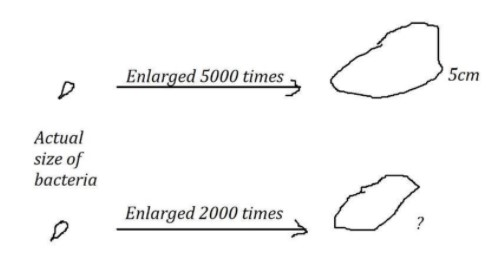Answer
424.2k+ views
Hint:The length of the photograph is given for a certain value of enlargement. But to get the actual value of the length of the bacteria, we need to divide with that certain value. And after that to find out for any kind of other enlargement value, directly you can multiply that with the actual length of the bacteria.
Complete step-by-step answer:
When we clearly look at the question, they mentioned that the bacteria when it is enlarged for \[50,000\] times it attains the length of $5cm$.
So, if we want to find out the actual length of the bacteria then we should divide the length obtained value with the how many times the bacteria are enlarged.

In simple words, it gives the length of the bacteria when the photograph is enlarged for unity it means no enlargement at all.
So, from the data we can obtain that the length of bacteria after enlargement is $5cm$ and enlarged \[50,000\] times. Substituting these values, we get as follows:
Actual length of the bacteria $ = \dfrac{5}{{50000}}$
$
= \dfrac{1}{{10000}} \\
= {10^{ - 4}}cm \\
$
As per now, we got the actual length of the bacteria and that is ${10^{ - 4}}cm$.
Now we can able to calculate the length of bacteria for any amount of enlargement value by simply multiplying with the unity value that we obtained recently.
In the second part of the question, we are asked to find out the length of the bacteria if the photograph is enlarged for the $20,000$ times.
So, just multiply this enlargement value with the actual length of the bacteria.
We get as follows:
When the photograph of a bacteria is enlarged $20,000$ times attains a length $ = 20000 \times {10^{ - 4}}= 2cm$
So, the bacterial will be visible with $2cm$ length when it is enlarged for the $20,000$ times.
Note:You are able to solve this problem in other ways also. We need to look at the proportions between the times that enlarged for data is given and the time enlarged for data asked. In this problem firstly it is enlarged by \[50,000\] times but asked for $20,000$ times. The proportional ratio is $\dfrac{2}{5}$. So, simply multiplying $5cm$ with $\dfrac{2}{5}$, we will get the same answer.
Complete step-by-step answer:
When we clearly look at the question, they mentioned that the bacteria when it is enlarged for \[50,000\] times it attains the length of $5cm$.
So, if we want to find out the actual length of the bacteria then we should divide the length obtained value with the how many times the bacteria are enlarged.

In simple words, it gives the length of the bacteria when the photograph is enlarged for unity it means no enlargement at all.
So, from the data we can obtain that the length of bacteria after enlargement is $5cm$ and enlarged \[50,000\] times. Substituting these values, we get as follows:
Actual length of the bacteria $ = \dfrac{5}{{50000}}$
$
= \dfrac{1}{{10000}} \\
= {10^{ - 4}}cm \\
$
As per now, we got the actual length of the bacteria and that is ${10^{ - 4}}cm$.
Now we can able to calculate the length of bacteria for any amount of enlargement value by simply multiplying with the unity value that we obtained recently.
In the second part of the question, we are asked to find out the length of the bacteria if the photograph is enlarged for the $20,000$ times.
So, just multiply this enlargement value with the actual length of the bacteria.
We get as follows:
When the photograph of a bacteria is enlarged $20,000$ times attains a length $ = 20000 \times {10^{ - 4}}= 2cm$
So, the bacterial will be visible with $2cm$ length when it is enlarged for the $20,000$ times.
Note:You are able to solve this problem in other ways also. We need to look at the proportions between the times that enlarged for data is given and the time enlarged for data asked. In this problem firstly it is enlarged by \[50,000\] times but asked for $20,000$ times. The proportional ratio is $\dfrac{2}{5}$. So, simply multiplying $5cm$ with $\dfrac{2}{5}$, we will get the same answer.
Recently Updated Pages
How many sigma and pi bonds are present in HCequiv class 11 chemistry CBSE

Why Are Noble Gases NonReactive class 11 chemistry CBSE

Let X and Y be the sets of all positive divisors of class 11 maths CBSE

Let x and y be 2 real numbers which satisfy the equations class 11 maths CBSE

Let x 4log 2sqrt 9k 1 + 7 and y dfrac132log 2sqrt5 class 11 maths CBSE

Let x22ax+b20 and x22bx+a20 be two equations Then the class 11 maths CBSE

Trending doubts
Fill the blanks with the suitable prepositions 1 The class 9 english CBSE

At which age domestication of animals started A Neolithic class 11 social science CBSE

Which are the Top 10 Largest Countries of the World?

Give 10 examples for herbs , shrubs , climbers , creepers

Difference between Prokaryotic cell and Eukaryotic class 11 biology CBSE

Difference Between Plant Cell and Animal Cell

Write a letter to the principal requesting him to grant class 10 english CBSE

Change the following sentences into negative and interrogative class 10 english CBSE

Fill in the blanks A 1 lakh ten thousand B 1 million class 9 maths CBSE



